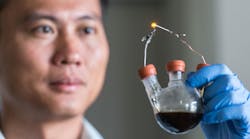Today’s electrical grid can’t tolerate the large and sudden power fluctuations caused by wide swings in sunlight and wind, adding to the difficulties in harnessing these alternate sources of energy. But the SLAC National Accelerator Laboratory and Stanford University are developing a low-cost, long-life battery that could manage these changes and enable a larger role for wind and power in the nation’s energy supply.
Solar and wind combined now contribute nearly 20% of the grid’s available electricity. As a result, energy storage systems are needed to level the peaks and valleys of this “intermittent” power, storing excess energy and discharging it when input drops. “Flow” batteries offer promise for intermittent storage because it’s relatively simple to scale their tanks, pumps, and pipes to the sizes needed to handle large energy capacities.
Today’s flow batteries pump two different kinds of liquids through an interaction chamber where dissolved molecules undergo chemical reactions that store or give up energy. The chamber contains a membrane that only allows ions not involved in reactions to pass between the liquids while physically separating the active ions.
Related Articles
• Researchers Turn Trees Into Solar Cells
• Wind Turbines Play In Paradise, But Not Falmouth
• Don’t Expect Large Wind Plants To Provide A Lot Of Energy Yet
The researchers say that this design has two major drawbacks, though: the high cost of liquids containing rare minerals such as vanadium, especially in the huge quantities needed for grid storage, and the membrane, which also is very expensive and requires frequent maintenance. Instead, the researchers offer a simplified and less expensive design that’s fit for large-scale production.
The new design uses only one stream of molecules and doesn’t need a membrane at all. Its molecules mostly consist of the relatively inexpensive elements lithium and sulfur, which interact with a piece of lithium metal coated with a barrier that permits electronics to pass without degrading the metal.
When discharging, the molecules, called lithium polysulfides, absorb lithium ions. When charging, they lose the lithium ions back into the liquid. The entire molecular stream is dissolved in an organic solvent that doesn’t have the corrosion issues of water-based flow batteries.
Researchers said that the battery retained excellent energy-storage performance through more than 2000 charges and discharges in initial lab tests, equal to more than five and a half years of daily cycles. They demonstrated their concept with a miniature system using simple glassware (see the figure). Adding a lithium-polysulfide solution to the flask immediately produces electricity that lights an LED.
A utility version of the battery would be scaled up to store many megawatt-hours of energy. Next, the researchers plan to make a laboratory-scale system to optimize its energy storage process and identify potential engineering issues. They also expect to start discussions with potential hosts for a full-scale field-demonstration unit.
Stanford University
SLAC National Accelerator Laboratory

